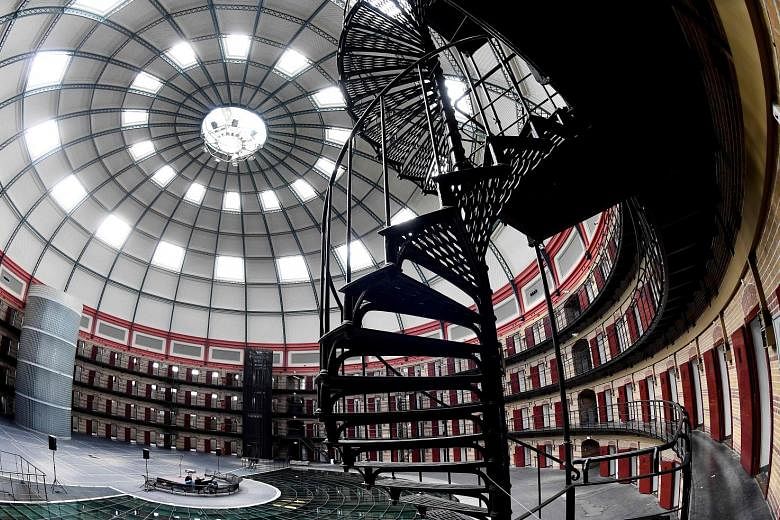BREDA (Netherlands) •Can new uses be unlocked to fill up empty prisons?
Take the case of the Breda prison, which was built in 1886 and closed in 2014. It is now an office space that is home to 90 businesses.
Voices now echo around its magnificent, luminous dome, breaking the silence of the 130-year-old building.
Most of the architectural design is preserved. Metal spiral staircases snake all around the dome down to the former canteen under the glass floor. Old sports areas are marked out on concrete, all are surrounded by cells stacked four storeys high, their now-rusted doors swinging open.
Mr Miguel de Waard, co-founder of the 3D Red Panda VR start-up, is among those who believe they have found a perfect office location, helping give new life to a protected national monument. "We just instantly fell in love with this particular office - the high ceiling, nice touches and big windows and lighting. We don't see bars, I think, when we look outside, we just see a beautiful part of Breda," he says.
There are now only 38 prisons still in operation in the Netherlands, with 27 closed since 2014.
Six were sold for about US$23 million (S$32 million) while others have been rented out often as centres for asylum seekers.
After leaping crime rates swelled Europe's prison population in the 1990s, numbers in the Netherlands have dropped, thanks, in part, to prevention programmes and a greater focus on reintegration.
Judges are sentencing people in different ways. Not more lightly, but differently, with community service and rehabilitation clinics.
Crimes fell by 26 per cent between 2007 and 2015, according to the Central Statistics Bureau.
In a decade, the number of people imprisoned every year in the Netherlands fell from 50,650 in 2005 to 37,790 in 2015.
The rate of incarceration stands at 57 prisoners for every 100,000 residents, compared with 458 in the United States.
So the Dutch have sought to put their empty prison cells to good use. A detention centre in northern Veenhuizen has been rented out to Norway to house its inmates. A former women's jail in northeastern Zwolle is now an award- winning restaurant.
A penitentiary in Amsterdam is to be transformed into a residential district with thousands of homes.
And a centre in Haarlem, bought by the local municipality, will open in 2019 as a university college.
In Breda, the prison's 358,330 sq ft space was handed over to a special body last year to be used for "social" projects.
Ms Mandy Jak, communications and marketing adviser for Dutch property managing firm VPS, says: "That was our biggest challenge - to open the prison again."
But interest has been huge, with about 300 people swiftly signing up to move in. She adds: "It actually feels like not a prison any more... It looks like a prison, of course, but with all those start-ups, it's got new energy."
However, one summer evening, new "inmates" were spotted, as about 350 people were locked in, taking part in, perhaps, the ultimate Prison Escape adult adventure game, popular in many countries. Barricaded into the cells, participants have to plot an escape over three hours with the help of about 80 actors.
Once rid of these thrill-seekers, the building again sank into silence. Until the next business day.
AGENCE FRANCE-PRESSE

